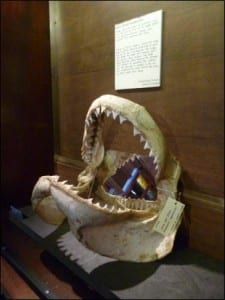I found this… great white shark
By Emma-Louise Nicholls, on 11 October 2012
I found this… is a new mini-installation by the entrance to the Museum. In each of the six cabinets one member of our team has selected one object which they have uncovered something new about. Today…
The great white shark jaws
 People often ask where our specimens came from. The truth for some of the oldest objects is we don’t know. However, whoever first acquired this specimen left clues.
People often ask where our specimens came from. The truth for some of the oldest objects is we don’t know. However, whoever first acquired this specimen left clues.
During my Ph.D on sharks I learnt that large species attack using the front right, or front left of the jaw. This specimen has empty pits where two teeth are missing from this primary biting location. The teeth either side are intact, showing the damage was caused by something thin: fishing line. The damage is isolated to the top jaw, suggesting the shark tried to get away by diving rather than rolling.
It is sad to think of how this animal died. Great white sharks are the subject of much debate at the moment. On one side of the argument is the welfare of the shark… They are currently classified as vulnerable on the IUCN Red List and are suffering, as with most shark species, from being over-fished, either through the ever wasteful phenomenon of bycatch, or from being deliberately caught for flesh, skins, oil and fins to fuel the horrific shark-fin soup trade. Great whites specifically, also suffer from being big and impressive, meaning people want the ‘kudos’ of catching them and the momento of the jaws on their living room wall. The other side of the argument is the welfare of humans… Human injuries caused by interactions with great white sharks have increased recently. Unfortunately, people take the panic route and demonise the sharks whilst governments, which feel the need to be seen to be doing something, take the easy option of bandying about terms and phrases such as ‘cull’ and ‘shark numbers are clearly increasing, they should be taken off the endangered list so they can be hunted’, etc, etc. What few people seem to grasp is that human populations are increasing, and consequently, more people are swimming in the sea, meaning that more people are coming into contact with wild sharks. So of course, the number of injuries are increasing. But it is much easier and neater to blame the shark than to face the truth that it may be our fault.
 Close
Close


UPDATE:
As a result of this blog being posted, a shark researcher contacted the museum to say he didn’t think the jaws belonged to a great white. Whilst relieved to say it wasn’t me who originally identified the jaws as great white, I definitely should have taken a closer look before now! It is not known whether the jaws were originally identified as belonging to a great white by the person who donated them, or by a previous researcher at the museum. Either way, it is great that the researcher got in touch, and we could correct the mistake. This is a great example of information acquired through crowd sourcing which is something we encourage and appreciate here at the museum. As they suggested, they are in fact bull shark jaws. Everything in the blog about the specimen still applies.